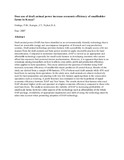| dc.description.abstract | Draft animal power (DAP) has been identified as an environmentally friendly technology that is based on renewable energy and encompasses integration of livestock and crop production systems. Draft animal technology provides farmers with a possibility to cheaply access al1d use manure from the draft animals and farm power needed to apply renewable practices for land intensification. Compared to motorized mechanization, DAP is viewed as an appropriate and affordable technology especially for small-scale farmers in developing countries who cannot afford the expensive fuel-powered tractor mechanization. However, it is apparent that there is no consensus among researchers on how it affects crop yields, profit and production efficiency when applied in farm operations. This study addressed the question of whether using DAP increases economic efficiency of smallholder maize producers ill central Kenya. Results of the study are derived from a sample of 80 farmers, 57% of whom used draft animals while 43% used hand hoes in carrying farm operations. In the study area, draft animals are almost exclusively used for land preparation and planting with very few fanners applying them in the consecutive operations such as weeding. A profit function was estimated to test the hypothesis of equal economic efficiency between 'DAP' and 'hoe' farms, The results showed that farmers who used DAP obtained higher yields and operated at a higher economic efficiency compared to those who used hand hoes. The analysis underscores the viability of DAP in increasing profitability of small-scale farms; however, other aspects of the technology such as affordability of the whole DAP package, availability of appropriate implements and skills of using the technology must be taken into account when promoting adoption of DAP technology. | en |

